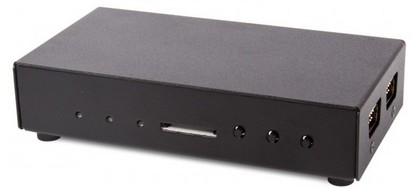The MIST core has timing issues and does not get synthesized correctly. Some implementations do seem to work nicely but others fail from the very beginning.
Constraints and operating conditions need some redifinition and the design probably needs some refinement too in order to avoid these timing problems.
TimeQuest Timing Analyzer Summary
Type : Slow 1200mV 85C Model Setup 'clock|altpll_component|auto_generated|pll1|clk[1]'
Slack : -9.438
TNS : -1947.729
Type : Slow 1200mV 85C Model Setup 'clock|altpll_component|auto_generated|pll1|clk[0]'
Slack : -5.792
TNS : -380.770
Type : Slow 1200mV 85C Model Setup 'sdclk_pin'
Slack : -4.515
TNS : -70.551
Type : Slow 1200mV 85C Model Hold 'clock|altpll_component|auto_generated|pll1|clk[1]'
Slack : -3.855
TNS : -246.855
Type : Slow 1200mV 85C Model Hold 'sdclk_pin'
Slack : -1.071
TNS : -1.071
Type : Slow 1200mV 85C Model Hold 'clock|altpll_component|auto_generated|pll1|clk[0]'
Slack : 0.454
TNS : 0.000
Type : Slow 1200mV 85C Model Recovery 'clock|altpll_component|auto_generated|pll1|clk[1]'
Slack : 11.782
TNS : 0.000
Type : Slow 1200mV 85C Model Removal 'clock|altpll_component|auto_generated|pll1|clk[1]'
Slack : 18.677
TNS : 0.000
Type : Slow 1200mV 85C Model Minimum Pulse Width 'clock|altpll_component|auto_generated|pll1|clk[2]'
Slack : -3.952
TNS : -3.952
Type : Slow 1200mV 85C Model Minimum Pulse Width 'sdclk_pin'
Slack : -3.952
TNS : -3.952
Type : Slow 1200mV 85C Model Minimum Pulse Width 'clock|altpll_component|auto_generated|pll1|clk[0]'
Slack : 3.498
TNS : 0.000
Type : Slow 1200mV 85C Model Minimum Pulse Width 'clock|altpll_component|auto_generated|pll1|clk[1]'
Slack : 15.084
TNS : 0.000
Type : Slow 1200mV 85C Model Minimum Pulse Width 'clk_27'
Slack : 18.384
TNS : 0.000
Type : Slow 1200mV 0C Model Setup 'clock|altpll_component|auto_generated|pll1|clk[1]'
Slack : -8.486
TNS : -1542.736
Type : Slow 1200mV 0C Model Setup 'clock|altpll_component|auto_generated|pll1|clk[0]'
Slack : -4.993
TNS : -269.462
Type : Slow 1200mV 0C Model Setup 'sdclk_pin'
Slack : -3.484
TNS : -54.185
Type : Slow 1200mV 0C Model Hold 'clock|altpll_component|auto_generated|pll1|clk[1]'
Slack : -3.620
TNS : -234.595
Type : Slow 1200mV 0C Model Hold 'sdclk_pin'
Slack : -1.053
TNS : -1.053
Type : Slow 1200mV 0C Model Hold 'clock|altpll_component|auto_generated|pll1|clk[0]'
Slack : 0.402
TNS : 0.000
Type : Slow 1200mV 0C Model Recovery 'clock|altpll_component|auto_generated|pll1|clk[1]'
Slack : 12.003
TNS : 0.000
Type : Slow 1200mV 0C Model Removal 'clock|altpll_component|auto_generated|pll1|clk[1]'
Slack : 18.360
TNS : 0.000
Type : Slow 1200mV 0C Model Minimum Pulse Width 'clock|altpll_component|auto_generated|pll1|clk[2]'
Slack : -3.952
TNS : -3.952
Type : Slow 1200mV 0C Model Minimum Pulse Width 'sdclk_pin'
Slack : -3.952
TNS : -3.952
Type : Slow 1200mV 0C Model Minimum Pulse Width 'clock|altpll_component|auto_generated|pll1|clk[0]'
Slack : 3.361
TNS : 0.000
Type : Slow 1200mV 0C Model Minimum Pulse Width 'clock|altpll_component|auto_generated|pll1|clk[1]'
Slack : 14.984
TNS : 0.000
Type : Slow 1200mV 0C Model Minimum Pulse Width 'clk_27'
Slack : 18.369
TNS : 0.000
Type : Fast 1200mV 0C Model Setup 'clock|altpll_component|auto_generated|pll1|clk[1]'
Slack : -0.666
TNS : -1.178
Type : Fast 1200mV 0C Model Setup 'sdclk_pin'
Slack : -0.618
TNS : -9.021
Type : Fast 1200mV 0C Model Setup 'clock|altpll_component|auto_generated|pll1|clk[0]'
Slack : -0.491
TNS : -0.828
Type : Fast 1200mV 0C Model Hold 'clock|altpll_component|auto_generated|pll1|clk[1]'
Slack : -1.697
TNS : -112.795
Type : Fast 1200mV 0C Model Hold 'sdclk_pin'
Slack : -0.987
TNS : -0.987
Type : Fast 1200mV 0C Model Hold 'clock|altpll_component|auto_generated|pll1|clk[0]'
Slack : 0.185
TNS : 0.000
Type : Fast 1200mV 0C Model Recovery 'clock|altpll_component|auto_generated|pll1|clk[1]'
Slack : 13.793
TNS : 0.000
Type : Fast 1200mV 0C Model Removal 'clock|altpll_component|auto_generated|pll1|clk[1]'
Slack : 16.989
TNS : 0.000
Type : Fast 1200mV 0C Model Minimum Pulse Width 'clock|altpll_component|auto_generated|pll1|clk[2]'
Slack : -0.031
TNS : -0.031
Type : Fast 1200mV 0C Model Minimum Pulse Width 'sdclk_pin'
Slack : -0.031
TNS : -0.031
Type : Fast 1200mV 0C Model Minimum Pulse Width 'clock|altpll_component|auto_generated|pll1|clk[0]'
Slack : 3.554
TNS : 0.000
Type : Fast 1200mV 0C Model Minimum Pulse Width 'clock|altpll_component|auto_generated|pll1|clk[1]'
Slack : 15.283
TNS : 0.000
Type : Fast 1200mV 0C Model Minimum Pulse Width 'clk_27'
Slack : 17.946
TNS : 0.000



